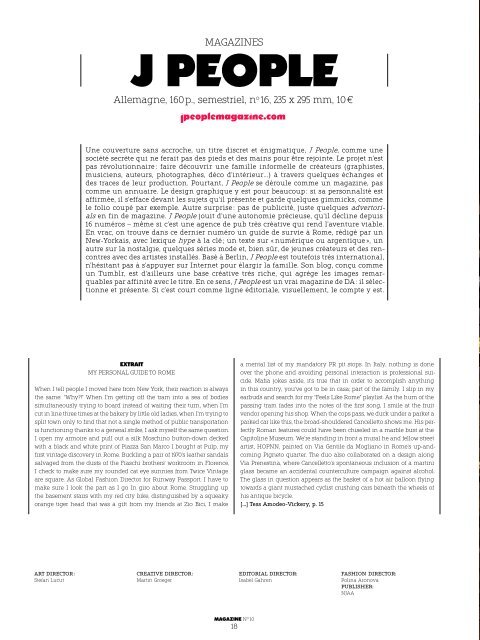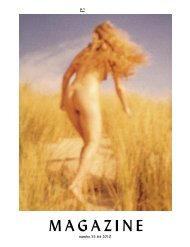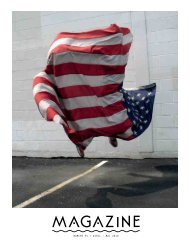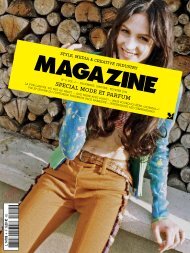Télécharger - Magazine
Télécharger - Magazine
Télécharger - Magazine
You also want an ePaper? Increase the reach of your titles
YUMPU automatically turns print PDFs into web optimized ePapers that Google loves.
MAGAZINES<br />
J People<br />
Allemagne, 160 p., semestriel, n o 16, 235 x 295 mm, 10 €<br />
jpeoplemagazine.com<br />
Une couverture sans accroche, un titre discret et énigmatique, J People, comme une<br />
société secrète qui ne ferait pas des pieds et des mains pour être rejointe. Le projet n’est<br />
pas révolutionnaire : faire découvrir une famille informelle de créateurs (graphistes,<br />
musiciens, auteurs, photographes, déco d’intérieur…) à travers quelques échanges et<br />
des traces de leur production. Pourtant, J People se déroule comme un magazine, pas<br />
comme un annuaire. Le design graphique y est pour beaucoup : si sa personnalité est<br />
affirmée, il s’efface devant les sujets qu’il présente et garde quelques gimmicks, comme<br />
le folio coupé par exemple. Autre surprise : pas de publicité, juste quelques advertorials<br />
en fin de magazine. J People jouit d’une autonomie précieuse, qu’il décline depuis<br />
16 numéros – même si c’est une agence de pub très créative qui rend l’aventure viable.<br />
En vrac, on trouve dans ce dernier numéro un guide de survie à Rome, rédigé par un<br />
New-Yorkais, avec lexique hype à la clé ; un texte sur « numérique ou argentique », un<br />
autre sur la nostalgie, quelques séries mode et, bien sûr, de jeunes créateurs et des rencontres<br />
avec des artistes installés. Basé à Berlin, J People est toutefois très international,<br />
n’hésitant pas à s’appuyer sur Internet pour élargir la famille. Son blog, conçu comme<br />
un Tumblr, est d’ailleurs une base créative très riche, qui agrège les images remarquables<br />
par affinité avec le titre. En ce sens, J People est un vrai magazine de DA : il sélectionne<br />
et présente. Si c’est court comme ligne éditoriale, visuellement, le compte y est.<br />
Extrait<br />
My personal guide to Rome<br />
When I tell people I moved here from New York, their reaction is always<br />
the same: “Why?!” When I’m getting off the tram into a sea of bodies<br />
simultaneously trying to board instead of waiting their turn, when I’m<br />
cut in line three times at the bakery by little old ladies, when I’m trying to<br />
split town only to find that not a single method of public transportation<br />
is functioning thanks to a general strike, I ask myself the same question.<br />
I open my armoire and pull out a silk Moschino button-down decked<br />
with a black and white print of Piazza San Marco I bought at Pulp, my<br />
first vintage discovery in Rome. Buckling a pair of 1970’s leather sandals<br />
salvaged from the dusts of the Fiaschi brothers’ workroom in Florence,<br />
I check to make sure my rounded cat eye sunnies from Twice Vintage<br />
are square. As Global Fashion Director for Runway Passport, I have to<br />
make sure I look the part as I go In giro about Rome. Struggling up<br />
the basement stairs with my red city bike, distinguished by a squeaky<br />
orange tiger head that was a gift from my friends at Zio Bici, I make<br />
a mental list of my mandatory PR pit stops. In Italy, nothing is done<br />
over the phone and avoiding personal interaction is professional suicide.<br />
Mafia jokes aside, it’s true that in order to accomplish anything<br />
in this country, you’ve got to be in casa; part of the family. I slip in my<br />
earbuds and search for my “Feels Like Rome” playlist. As the hum of the<br />
passing tram fades into the notes of the first song, I smile at the fruit<br />
vendor opening his shop. When the cops pass, we duck under a parket a<br />
parked car like this, the broad-shouldered Cancelletto shows me. His perfectly<br />
Roman features could have been chiseled in a marble bust at the<br />
Capitoline Museum. We’re standing in front a mural he and fellow street<br />
artist, HOPNN, painted on Via Gentile da Mogliano in Rome’s up-andcoming<br />
Pigneto quarter. The duo also collaborated on a design along<br />
Via Prenestina, where Cancelletto’s spontaneous inclusion of a martini<br />
glass became an accidental counterculture campaign against alcohol.<br />
The glass in question appears as the basket of a hot air balloon flying<br />
towards a giant mustached cyclist crushing cars beneath the wheels of<br />
his antique bicycle.<br />
[…] Tess Amodeo-Vickery, p. 15<br />
Art director :<br />
Stefan Lucut<br />
Creative director :<br />
Martin Groeger<br />
editorial director:<br />
Isabel Gahren<br />
fashion director:<br />
Polina Aronova<br />
Publisher:<br />
NJAA<br />
magazine n o 10<br />
18











